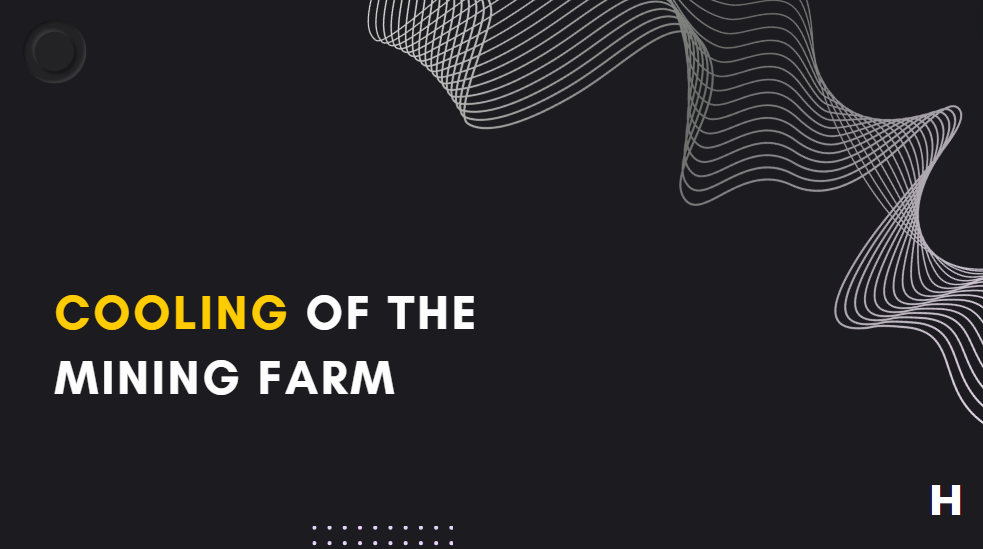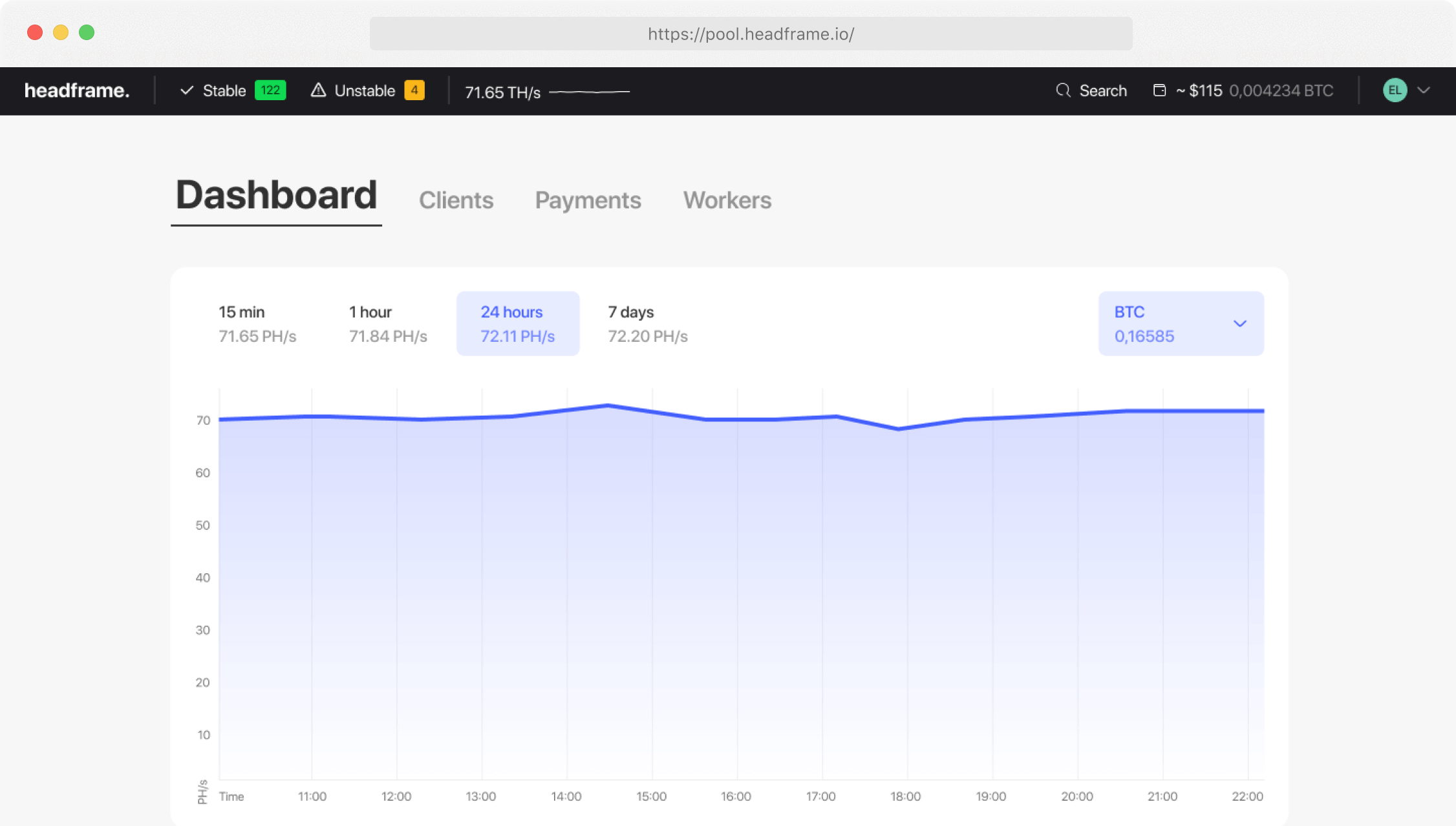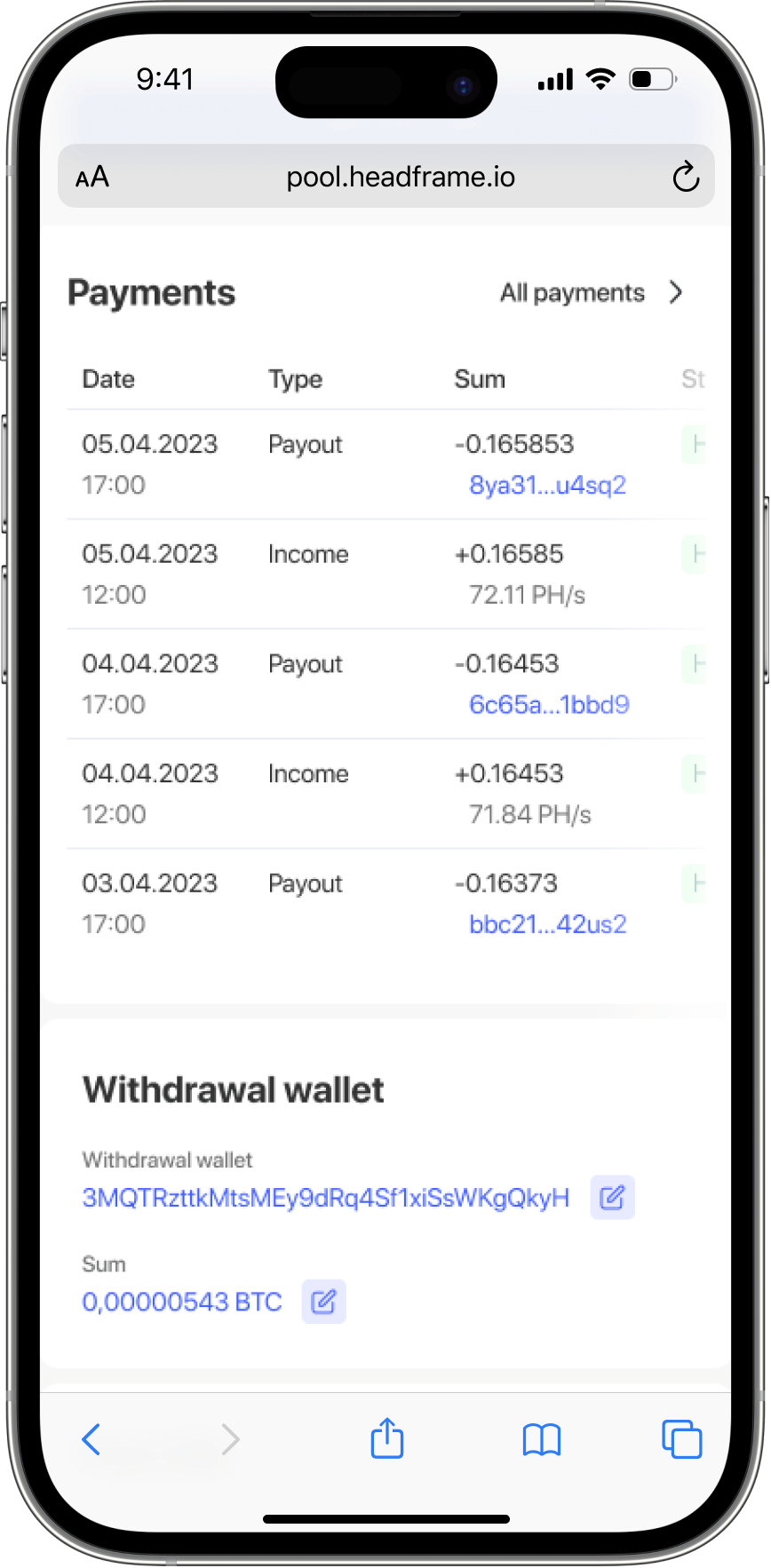
Cooling a mining farm: methods, fans and schemes
- Cooling of a mining farm
- Mining farm heat dissipation
- Mining farm heat distribution
- Cooling a Mining Farm: Heat Distribution Methods
- Factors affecting heat distribution
- Managing heat distribution
- Cooling a mining farm in summer
- Cooling a mining farm on a balcony
- Cooling of video cards for mining
- Cooling scheme for a mining farm
- Best Fans for Mining in 2023
- FAQs
Cooling a mining farm
Earn more money with Headframe
Join a mining pool and get the best profitability in mining. Already more than 10,000 miners trust Headframe.
Mining farms, especially those that mine cryptocurrency such as Bitcoin, require significant processing power. This power is provided by specialized hardware that performs complex calculations. However, these calculations generate a lot of heat, and if this heat is not properly controlled, it can damage the equipment and reduce the efficiency of the mining operation. Why do you need cooling in a mining farm? Cooling is important in a mining farm because the process of mining cryptocurrencies involves solving complex math problems, which requires a lot of processing power. This process generates a lot of heat. If the heat is not managed properly, it can lead to hardware failures, reduced mining efficiency, or even complete system failure.
In 2023, advances in cooling technology may lead to new methods or improvements to existing methods. For example, there may be new types of coolers that are more efficient at absorbing heat, or new fan and radiator designs that improve air and liquid cooling systems.
Heat generation of a mining farm
Heat generation is a fundamental aspect of cryptocurrency mining because of the computationally intensive processes involved.
Here is a detailed explanation of why and how heat generation occurs during mining:
- Computational Intensity: Cryptocurrency mining involves solving complex mathematical problems to verify transactions and add them to the blockchain. This process requires a lot of processing power from the computer hardware.
- Hardware Utilization: The hardware used for mining, such as ASICs (Application-Specific Integrated Circuits) or GPUs (Graphics Processing Units), is under constant load for long periods of time. This high utilization results in the generation of a significant amount of heat.
- Energy Conversion: All electronic devices, including mining equipment, convert some portion of the electrical energy consumed into heat. This happens because of the resistance that electrical currents encounter as they pass through the electronic components of the device. In the case of mining equipment that consumes large amounts of electricity, this can result in significant heat generation.
- Inefficiency: No electronic device is 100% efficient, meaning that not all of the electrical energy consumed is converted into useful work (e.g. cryptocurrency mining). Inefficiency in this conversion process leads to additional heat generation.
- Continuous operation: Unlike many other electronic devices, mining equipment often operates without interruption. This continuous operation results in constant heat generation, which can build up over time if not managed properly.
Managing this heat generation is a critical aspect of a successful and safe mining operation. If heat is not properly dissipated, it can damage equipment, reduce its lifespan and performance, and in extreme cases can cause a fire hazard. Therefore, efficient cooling solutions and good air circulation are essential in any mining complex.
Heat distribution of a mining farm
Heat distribution is a critical aspect of managing a cryptocurrency mining farm. Mining hardware, such as an ASIC (application-specific integrated circuit) or GPU (graphics processing unit), generate a significant amount of heat due to the intensive computational operations they perform. If this heat is not properly controlled, it can damage the hardware, shorten its lifespan, and reduce the efficiency of mining.
Cooling a mining farm: Methods of heat distribution
- Air cooling: This is the most common method of heat distribution in a mining farm. It involves the use of fans to blow through the mining equipment, redirecting heat away from the devices. The hot air is then blown out of the mining area. This method is relatively simple and cost-effective, but its effectiveness can depend on the ambient temperature.
- Liquid cooling: This method involves circulating a liquid coolant around parts of the mining equipment to absorb heat. The heated liquid is then cooled in a radiator before being re-circulated. Liquid cooling is more efficient than air cooling, but it is also more difficult and expensive to implement.
- Immersion cooling: In this method, the mining equipment is completely immersed in a non-conductive liquid that absorbs heat. This method can be very effective, but its implementation requires specialized equipment and maintenance.
Factors affecting heat distribution
Several factors can affect the efficiency of heat distribution in a mining farm:
- Ambient temperature: The effectiveness of heat distribution methods, especially air cooling, can be significantly affected by ambient temperature. High ambient temperature makes it more difficult to cool the mining equipment.
- Humidity: High humidity can reduce the effectiveness of air cooling and increase the risk of condensation, which can lead to equipment damage.
- Airflow: Proper airflow is an important factor for efficient heat distribution. The placement of the mining farm should be designed to allow cool air to flow to the equipment and push hot air out.
- Equipment Configuration: The configuration of the mining equipment can also affect heat distribution. For example, tightly installed equipment may be more difficult to cool effectively.
Managing heat distribution
Effective heat management in a mining farm involves a combination of selecting an appropriate cooling method, designing the location of the farm to allow airflow, and regularly monitoring temperature and humidity. You may also need to customize the operation of the mining equipment, such as lowering the clock frequency of devices, to reduce heat generation.
Cooling a mining farm in the summer
During the summer months, the outside temperature rises, which can exacerbate the problem of overheating inside the mining farm. Therefore, additional cooling measures may be required.
Here are a few strategies:
- Air conditioning: Although it can be costly, air conditioning can help keep the temperature inside a mining farm at a manageable level. This is especially useful during peak heat in the summer.
- Ventilation: Increasing ventilation in a mining farm can help get rid of hot air faster and attract cool air. This can include installing additional fans or improving the layout of the farm to allow for better air circulation.
- Water cooling systems: These systems use water to absorb heat from the mining equipment. The superheated water is cooled in a radiator before being re-circulated. While water cooling systems are more complex and expensive to install, they can be more efficient than air cooling, which is especially important during the hot summer months.
Cooling a mining farm on a balcony
Cooling a mining farm on a balcony presents special challenges and opportunities. An outdoor location can provide natural ventilation, but it can also present some risks.
Here are some tips:
- Weather-resistant equipment: Make sure your mining equipment and cooling systems are weather-resistant. This includes protection from rain, dust, and direct sunlight.
- Natural air circulation: If your balcony is in a location with good natural air circulation, you can use this to cool your mining farm. You may need to install additional fans to enhance this circulation.
- Shade: Protect your mining farm from direct sunlight, which can increase heating. Use curtains or awnings to block the sun.
- Consider noise: Mining equipment and cooling systems can be noisy. If your balcony is close to your living quarters or neighbors, you may need to take measures to reduce noise.
Remember, no matter where your mining farm is located, regular monitoring of temperature and humidity levels is critical to ensure the efficiency of your cooling systems and the health of your mining equipment.
Cooling graphics cards for mining
Video cards (GPU graphics cards) are often used in mining farms because they are good at handling the calculations required for mining. However, they can generate a lot of heat.
Here are some ways to cool them down:
- GPU coolers: These are devices specifically designed to cool graphics cards. They include heatsinks that draw heat away from the GPU and fans to dissipate heat.
- Thermal paste: Applying thermal paste between the GPU and the cooler can improve heat transfer.
- Liquid cooling: Some advanced mining rigs use liquid cooling for the GPU. This involves circulating liquid coolant around the GPU to absorb heat.
- Proper placement: Make sure there is enough space between your GPUs. If they are too close together, they can heat each other up.
Remember, efficient cooling is key to the longevity and efficiency of your mining farm. It’s always worth investing in a good cooling system to protect your hardware.
Cooling scheme for a mining farm
A cooling scheme for a mining farm is a plan or strategy for managing the heat generated by the mining equipment. This scheme is a key element in maintaining the optimal operating temperature of the mining equipment and ensuring its longevity and efficiency.
Here is a basic overview of the cooling scheme:
Heat Generation: The first part of the circuit is related to the mining hardware itself. When performing the complex calculations required for mining, the hardware generates a significant amount of heat.
Heat dissipation: The next part of the circuit is to dissipate the heat generated by the equipment. This can be done in a variety of ways, including air cooling, liquid cooling, and immersion cooling.
Air cooling: This method involves using fans to blow cold air through the mining equipment, taking away the heat. The hot air is then blown out of the mining area. This is the simplest and most common method of cooling in a mining farm.
Liquid cooling: This method involves circulating a liquid coolant around parts of the mining equipment to absorb heat. The heated liquid is then cooled in a radiator before being re-circulated. This method is more efficient, but is also more complex and expensive to implement.
Immersion cooling: This method involves immersing the mining equipment in a non-conductive liquid that absorbs heat. This method can be very effective, but is also difficult to implement and may require specialized equipment and maintenance.
Temperature Monitoring: The last part of the scheme is to regularly monitor the temperature of the mining equipment and the mining area. This allows necessary adjustments to be made to the cooling system to maintain optimal operating temperature.
This basic cooling scheme can be customized and expanded depending on the specific needs and resources of the mining farm. For example, larger mining farms may require a more advanced cooling system, while smaller farms can get by with simpler methods. Local climate can also influence the choice of cooling methods, with colder climates offering more passive cooling options.
Cooling scheme for a mining farm
In this scheme:
- The Mining Hardware generates Generates Heat.
- The Heat Dissipation System works to cool the mining hardware.
- In Air Cooling, Fans are used.
- In Liquid Cooling, a Liquid Cooling System is used.
- In Immersion Cooling, the hardware is immersed in a Non-Conductive Liquid.
The best fans for mining in 2023
| FAN MODEL | SIZE | NOISE LEVEL | SPEED |
| Noctua NF-S12B redux-1200 | 120 мм | Low | 1200 rpm |
| Vornado 630 Mid-Size Whole Room Air Circulator Fan | Average size | Medium | Variable |
| Honeywell HT-900 TurboForce Air Circulator Fan | Compact | Low | Variable |
| Arctic P12 PWM PST CO | 120 мм | 0.3 Sone | 200-1800 rpm |
- Noctua NF-S12B redux-1200: This fan is known for its substantial airflow and impressively low noise level. Its size is 120mm and its speed is 1200rpm.
- Vornado 630 Mid-Size Whole Room Air Circulator Fan: This fan is not specifically designed for mining rigs, but it has received high marks for its overall performance. It is a mid-size fan with variable speed. The noise level is average.
- Honeywell HT-900 TurboForce Air Circulator Fan: Another versatile fan, this model from Honeywell is noted for its value for money. It is a compact variable speed fan. The noise level is low.
- Arctic P12 PWM PST CO: The Arctic P12 PWM PST CO fan is specially designed for continuous operation. It is ideal for use in high performance cooling applications where maximum airflow is required. The fan operates at 200-1800 RPM and has a noise level of 0.3 Sone. The fan size is 120mm.
In conclusion, cooling is a critical aspect of running a mining farm, affecting the performance and lifespan of the hardware. Heat dissipation strategies include both passive and active cooling methods, including the use of heatsinks, thermal paste, and fans. In warmer seasons or warmer climates, additional cooling measures may be required, such as moving the mining farm to locations with better air circulation.
Cooling individual components such as graphics cards is also important due to the significant amount of heat they generate. Some of the best fans for mining in 2023 include Noctua NF-S12B redux-1200, Vornado 630, Honeywell HT-900, and Arctic P12 PWM PST CO, chosen for their performance, noise level, and speed. The best fan will depend on the specific needs of the mining rig. Effective cooling requires careful planning, selection of the right equipment, and regular monitoring.
FAQs
How to cool a mining farm in an apartment?
The most economical way to cool a room with a mining farm is to open a window and install a mosquito net. This allows fresh air to circulate around your rigs, helping to dissipate heat. However, it is important to consider the environmental conditions and ensure that your equipment is protected from elements such as dust.
What additional cooling methods for a mining farm can you suggest?
The method of cooling will depend on the specific conditions of your room. While using an air conditioner may seem like a good idea, it can consume a lot of electricity, making it a less efficient option. In cases where the room has no windows or loud fans may disturb your neighbors, an air conditioner may be a smart choice.
How to improve graphics card cooling for mining?
Graphics card cooling can be improved by providing it with sufficient ventilation. This can be achieved by positioning your mining rigs in a way that maximizes air circulation. In addition, using a quality thermal paste can improve heat transfer from the GPU to the heatsink. Regular dust cleaning of your graphics card can also help maintain optimal cooling performance.


